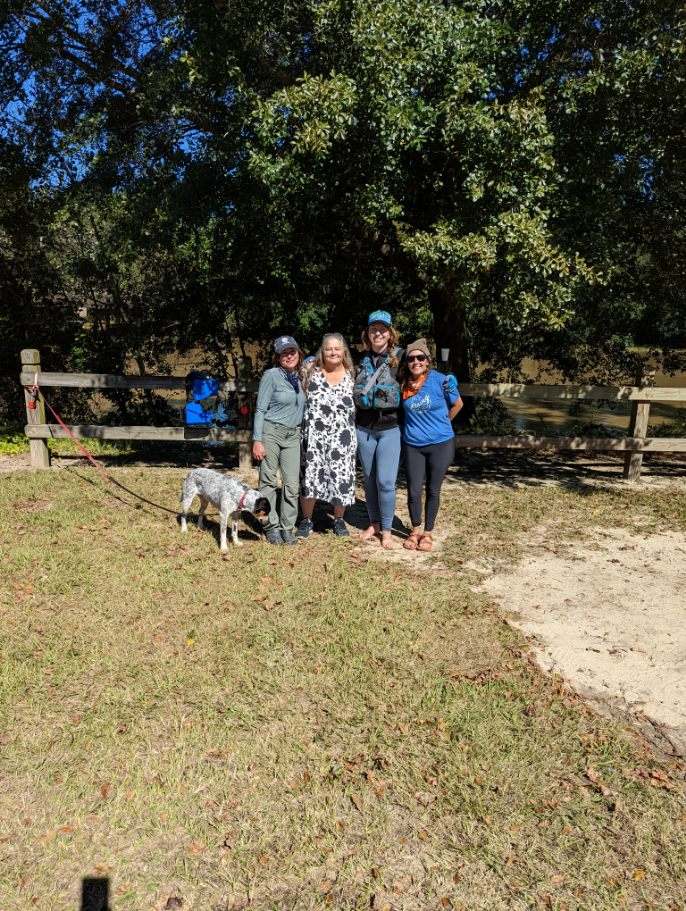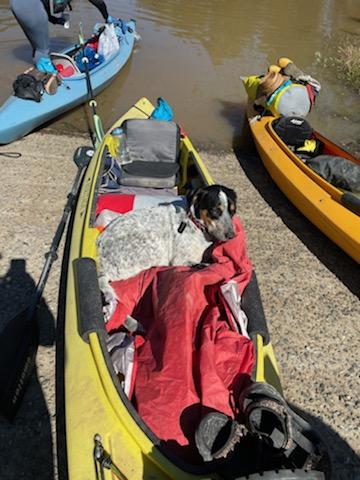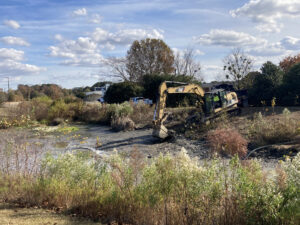News

DAY 7: MORNING UPDATE!
Jill and Samantha talking about the warm welcome from Seven Springs!
MID-DAY UPDATE
Jill describes the importance of the state’s swine buyout program and its impact on the future health of the Neuse and Tar-Pamlico Rivers
Day seven on the Neuse River was a dream. We woke up in the sleepy Town of Seven Springs feeling well rested and taken care of by the locals there who fed us a feast the night before. We took a leisurely morning and wandered the block or so from our campsite on the river to a little diner downtown. The place was perfect—delicious food made to order with no menus to speak of…just say what you want for breakfast and they’ll make. There we met a few more town locals and discussed more solutions to flooding and how the town could make use of all of the land along the river that was bought out by FEMA for flood prevention. While the law prevents permanent structures from being built on FEMA buyout land, the locals have plenty of ideas for how to use the land to benefit the community, like making community gardens and outdoor gathering places. Leaving the Town of Seven Springs was definitely bittersweet, and I know that all of us look forward to being back there again.
Our seventh day on the water was sunny and spotless, in stark contrast to the windy cold paddle that we had the day before. It seems that every day on the water just keeps getting more and more spectacular. As we paddled we couldn’t help but exclaim how beautiful everything is along the river, and how wild and remote it can feel even being many days downriver famous the famous undeveloped Let’Lones. It is amazing how much difference the buffer rules make when you are on the river. In our 16 miles of paddling we did not see much in the way of houses, or land-use changes, thanks to most people along the river respecting the buffer and keeping it green.
In the places where the buffer wasn’t respected, you could also see the difference. Pulling out the trees and vegetation from the riverside increases stream bank erosion and leads to the banks slowly being eaten away by the steady flow of the river. Houses and other structures along the riversides without that buffer are susceptible to one day being part of the river themselves. We are so thankful that the Neuse River is among one of the few watersheds in the state that has a legally required buffer protection. It’s hard to imagine what the river would look like otherwise.
One industry along the river that we were sure happy to be buffered from is swine factory farming. Unfortunately, swine farmers in North Carolina are still locked into an old way of storing hog waste, where open cesspools of liquid waste and sludge are stored outside confined animal feed-houses, in many places not far from the Neuse and its tributaries. Time has shown again and again that this practice of storing waste out in the open, especially along waterways, contributes more fecal bacteria and excess nutrients like nitrogen into surface waters and groundwater. We also know that these practices contribute air pollution and noxious smells that are obvious and detectable by neighbors to facilities and from the river itself. Paddling down the river yesterday we could smell the noxious odors of decomposing swine waste in several locations nearby these facilities.
In one location that we stopped at, the smells were specially odorous. This location was a facility that had flooded numerous times over the years as past hurricanes and significant rains came through the area. When a hog lagoon floods, all of the waste in that cesspool flows into our waterways, leading to disaster for water quality, aquatic species and the humans who rely on the river (all of us). This is why Sound Rivers and other conservation allies have been in support of the swine buyout program, that offers funding and support to farmers whose hog cesspools are in the floodplain and who are willing to move out of the floodplain to prevent future disaster. Unfortunately, swine buyout funding was not allocated in this year’s state budget, but we will continue working to ensure that there is funding and support available for farmers looking to do the right thing in the future.
We ended our glorious sunny day on the water at a friend and supporter’s beautiful home along the river just upstream of Kinston. There we were welcomed with a delicious feast of shrimp alfredo pasta and salad (which were always thankful for being without much greens on the water), and delightful company amongst friends.
Again, we are ever so grateful for all of the folks who are supporting our journey along the way, by providing places to stay, food, and warm smiling faces to greet us after a long days worth of paddling. We look forward to continuing our journey on day number eight, when we’ll arrive in Kinston. Stay tuned!












Related News

Position available: Stormwater Education Coordinator
April 18th 2024

Southern Nash next in line for stormwater projects
April 18th 2024

Xylem, Sound Rivers team up for cleanup
April 18th 2024

Sound Rivers launches new podcast
April 18th 2024

Swim Guide gearing up for a seventh season
April 11th 2024

Feedback needed for Jack’s Creek plans, projects
April 11th 2024

Pamlico-Tar Riverkeeper talks water quality
April 11th 2024

Pamlico-Tar Riverkeeper investigates Maple Branch turbidity
April 11th 2024

